As an Australian business owner or executive, you're no stranger to the relentless challenges of running a detailed-oriented, analytical operation in a competitive landscape. You pour your drive and persuasion into every decision, yet local talent shortages leave your teams stretched thin, high operational costs eat into profits, and outdated legacy systems hinder your ability to deliver exceptional customer experiences. These pains aren't just frustrating—they're barriers to achieving your goals of increased efficiency, reduced expenses, and higher revenues.
Imagine missing growth targets because you can't find skilled developers quickly enough, or watching competitors surge ahead with innovative tech while your organisation grapples with resistance to change and a lack of internal expertise. In today's data-driven world, these problems compound, leading to poor productivity, frustrated employees, and lost opportunities. The uncertainty of where to start—coupled with previous bad experiences with vendors—only heightens the risk of stagnation.
But there's a solution on the horizon: staff augmentation, particularly through remote and hybrid models, offers a flexible, innovative path forward. With the global IT staff augmentation market projected to reach USD 857.2 billion by 2031, driven by the permanence of remote work and hybrid setups that blend in-house and augmented teams, Australian executives are increasingly adopting this strategy to overcome local talent gaps. At C9, Australia's leading custom software, apps, integration, and database development company, we specialise in Development & Integration Team Staff Augmentation Services that address these exact pain points. Our innovative, trustworthy, and collaborative approach ensures you gain a competitive edge without the headaches of traditional hiring. Let's explore how mastering remote and hybrid staff augmentation can unlock unmatched growth for your business.
The Surge in Remote and Hybrid Staff Augmentation: Your Essential Strategy in a Talent-Scarce Australia
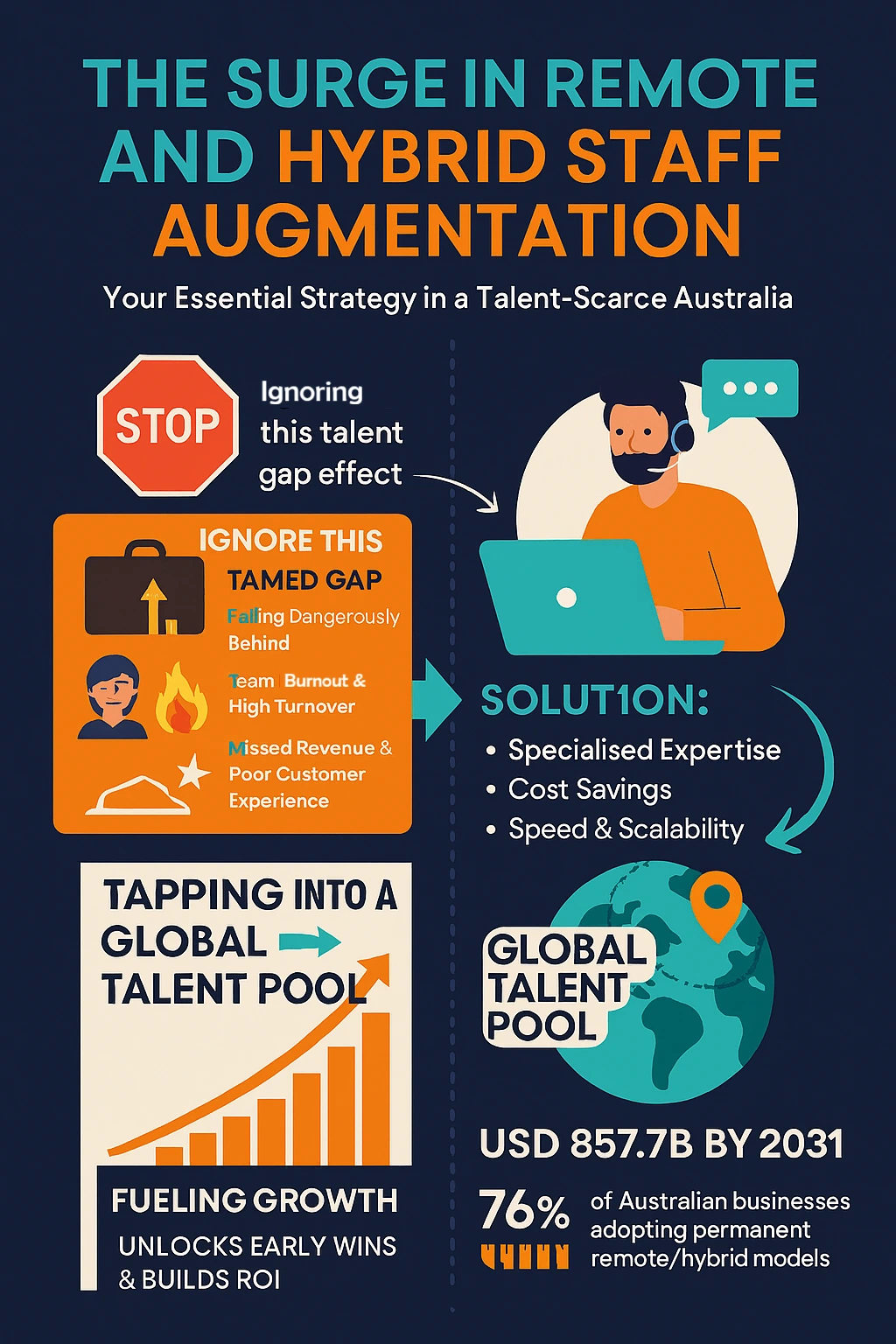
The shift to remote and hybrid work isn’t a temporary adjustment; it's a permanent transformation of the Australian business landscape. As a forward-thinking executive, you're already navigating this new reality, but one critical challenge looms larger than ever: an acute, ever-worsening shortage of top-tier tech talent. Recent data projects a staggering 25% rise in demand for software developers and related roles in Australia by 2031, a demand that the local talent pool simply cannot meet.
This isn't just an HR problem—it's a direct threat to your bottom line. The pain is tangible: mission-critical projects are delayed, innovation is stifled by outdated legacy systems, and the cost of hiring skyrockets, with average IT salaries in Australia now exceeding AUD 120,000 annually. You're caught in a frustrating loop of paying more for less, while the competition seems to be moving at lightspeed.
The Domino Effect: How Inaction Costs You More Than Just Money
Ignoring this talent gap isn't an option. The consequences ripple through every facet of your organisation, creating a domino effect that can erode your competitive position. Without a strategic response, your business risks:
-
Falling Dangerously Behind: While you're bogged down in six-month hiring cycles, agile competitors are leveraging global talent to launch new features, modernise their systems, and capture market share.
-
Team Burnout and High Turnover: Your existing team, overworked and stretched thin, becomes a hotbed for burnout. This leads to decreased productivity, a decline in code quality, and a high turnover rate, forcing you back into the same costly hiring cycle.
-
Missed Revenue and Poor Customer Experience: Delays in launching new products or fixing bugs in outdated systems directly impact your revenue. Worse, it leads to a poor customer experience, damaging your brand's reputation and driving your hard-won customers to your competitors. These are triggers no driven executive can afford to ignore.
The Solution: Tapping into a Global Talent Pool with Remote & Hybrid Augmentation
The solution isn't to just "try harder" in the local market; it's to think smarter and go global. Remote and hybrid staff augmentation offers a powerful, flexible, and cost-effective way to build the powerhouse tech team you need, precisely when you need it.
By looking to nearshore and offshore talent hubs in regions like Southeast Asia, Australian businesses are gaining unprecedented advantages. The Philippines, for example, has emerged as a premier destination, offering a vast pool of highly skilled, English-proficient IT professionals who share a strong cultural alignment with Australia. With minimal time differences (often just 2-3 hours), collaboration is seamless and efficient.
Market Growth Projections
This strategic shift is fueling explosive growth. The global IT staff augmentation sector was valued at USD 299.3 billion in 2023 and is projected to skyrocket to USD 857.2 billion by 2031, growing at a CAGR of 13.2%. In Australia, this is compounded by hybrid work trends, with 76% of businesses planning to maintain or expand remote work options to capitalise on cost savings and access to a global workforce.
Benefits for Australian Executives
For the analytical executive, the benefits are clear, measurable, and compelling:
-
Access to Specialised Expertise: Immediately tap into a global pool of specialists in high-demand fields like AI, cloud integration, and cybersecurity—skills that are often scarce and expensive locally.
-
Significant Cost Savings: Reduce operational expenses dramatically, with potential cost savings of up to 60% compared to the fully-loaded cost of a local hire.
-
Unmatched Agility and Scalability: Scale your development team up or down in weeks, not months, allowing you to respond instantly to project demands and market opportunities.
-
Reduced Team Burnout: Augmenting your team with dedicated experts alleviates the pressure on your in-house staff, boosting morale and allowing them to focus on core strategic initiatives.
From Barrier to Breakthrough with C9's Blended Model
Real-world triggers like outdated legacy systems can feel like insurmountable barriers, leading to poor customer experiences and internal inefficiencies. Staff augmentation provides the expert resources to modernise these systems swiftly, turning a major pain point into a competitive advantage. Australian SMEs that have adopted these blended models have reported 30-50% faster project delivery times, leading to a direct and immediate boost in profitability.
At C9, we’ve perfected this approach with our blended offshore and inshore team model. We harness the efficiency and deep talent pool of Southeast Asia while maintaining Australian-based leadership for governance, trust, and seamless communication. This isn't just outsourcing; it's a strategic partnership designed to integrate flawlessly with your operations, tackle your most pressing triggers, and drive your core business goals.
Beware the "AI Cowboys": The Hidden Dangers of "Vibes Coding"
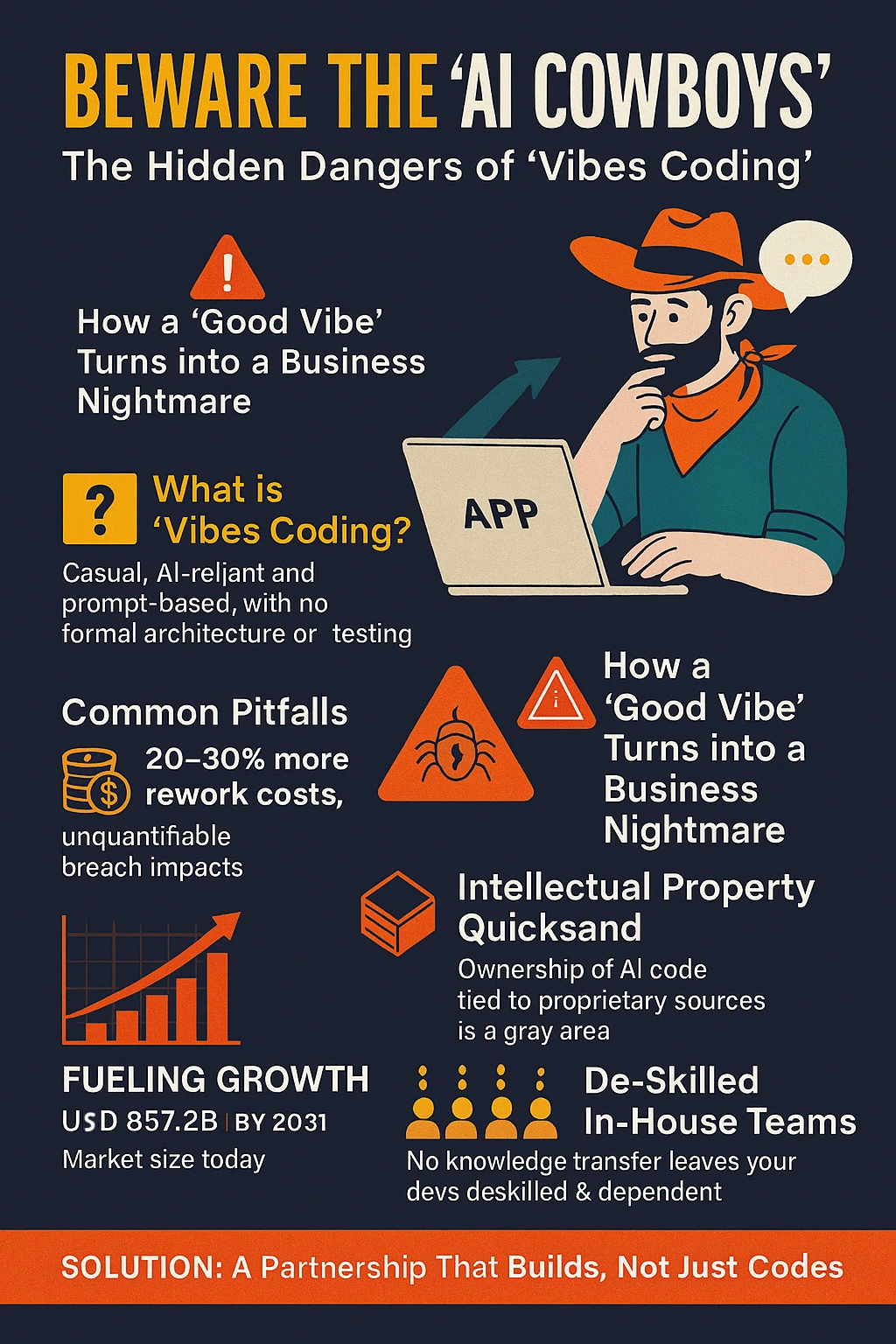
In the relentless race for innovation, the pressure to deliver projects faster and cheaper is immense. Your in-house team is stretched thin, and the hunt for top tech talent feels like an endless battle. In this environment, the siren song of "AI Cowboys"—freelancers or agencies promising to build custom applications at lightning speed for a fraction of the cost—can be incredibly tempting.
Their secret weapon? A risky practice called "vibes coding." This is a casual, prompt-based approach where developers rely heavily on AI to generate large blocks of code from natural language instructions, often skipping the rigorous planning, architectural design, and security protocols that define professional software development. The initial "pain" seems minor—you get a functional app quickly and cheaply, solving an immediate resource problem. But this shortcut is a ticking time bomb.
How a "Good Vibe" Turns into a Business Nightmare
Beneath the glossy surface of a quick-fix app lies a minefield of "gray areas" that can cripple your operations, inflate your costs, and expose your business to catastrophic risk.
What is "Vibes Coding?"
It's a casual, AI-reliant method where developers use natural language prompts to generate code without formal architecture or rigorous testing. This approach prioritizes speed over quality, often leading to unstructured and flawed outputs that are difficult to maintain or scale.
Common Pitfalls: A Cascade of Hidden Costs and Risks
Real-world cases show that businesses relying on poorly implemented AI-generated code face 20-30% higher rework costs down the line, not to mention the unquantifiable damage from security breaches and system failures.
Here’s what’s really at stake:
-
Security Nightmares and Brittle Architecture: AI models are trained on vast datasets of public code, including code that is outdated, insecure, or flawed. "AI Cowboys" often stitch this generated code together without a deep understanding of its underlying vulnerabilities. The result is a brittle application, like a skyscraper built on a foundation of sand. It might look fine on day one, but it's prone to collapse under the pressure of scaling user loads or a targeted cyberattack.
-
Intellectual Property Quicksand: Who owns AI-generated code? The legal landscape is a murky and evolving gray area. Since AI models are trained on countless sources, the code they produce can inadvertently contain proprietary snippets, creating a legal minefield of intellectual property infringement and ownership disputes that you may not discover until it's too late.
-
The Erosion of Your Greatest Asset—Your Team: When you rely on freelancers who use "vibes coding," there is zero knowledge transfer. They deliver a "black box" solution and disappear, leaving your in-house team with a codebase they can't understand, maintain, or evolve. This not only creates a dangerous dependency but also de-skills your own developers, preventing them from learning secure, modern architectural patterns and eroding your company's long-term technical capability. You're left with hidden technical debt that only grows more expensive over time.
The Solution: A Partnership That Builds, Not Just Codes
For forward-thinking executives, the math is simple. While "vibes coding" might offer a short-term budget win, it actively undermines long-term value, erodes institutional knowledge, and leaves your business vulnerable. True innovation requires a robust, secure, and sustainable foundation.
This is where C9’s expert-driven approach offers a clear alternative. We believe in using AI as a powerful tool to augment our experts, not replace them.
C9's Knowledge Transfer Advantage
We counter the "black box" problem by embedding education and collaboration into every engagement. Our expert developers don't just build your solution; they build your team's capability alongside it. Through paired programming, comprehensive documentation, and best-practice training, we ensure your team understands the "why" behind every architectural decision. This fosters independence, empowers your developers with cutting-edge skills, and ensures your custom software becomes a sustainable asset, not a future liability.
Choosing between a quick, cheap fix and a strategic, sustainable solution is a defining moment for any business leader. Don't let the allure of an "AI Cowboy" lead your business into a technical dead end.
Why Choose C9 Over Hundreds of Other Developers? Our Unique Edge
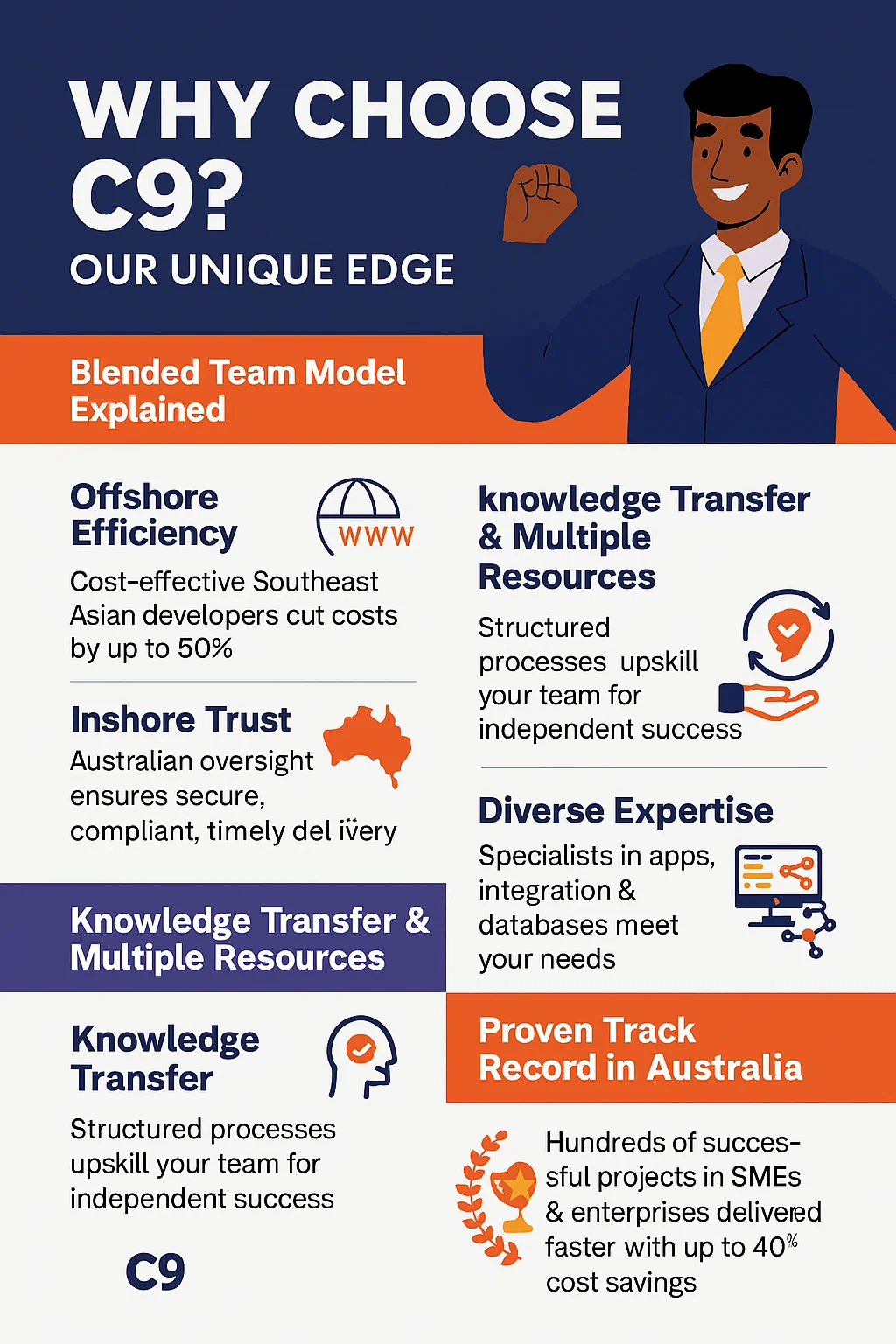
In the bustling Australian tech landscape, where hundreds of developers and agencies clamour for your attention, the pain of selection is all too real for business owners and executives like you. Uncertainty looms over which provider will truly understand your detailed-oriented needs, past vendor failures leave a trail of mistrust and wasted resources, and concerns over escalating costs create hesitation that stalls your drive toward innovation. These barriers—rooted in a lack of internal expertise and previous bad experiences—can paralyse decision-making, especially when you're already contending with high operational expenses and outdated legacy systems that demand precise, tailored solutions.
Choosing poorly doesn't just mean a mismatched solution; it cascades into resistance from your team, who may struggle with ill-fitting tech that disrupts workflows and erodes productivity. Wasted investments derail your goals, with industry reports showing that 70% of IT projects fail due to poor vendor alignment, leading to overruns averaging 189% and scope creep affecting 63% of initiatives. For analytical executives in Australia, this translates to missed growth targets, poor customer experiences from fragmented integrations, and a competitive disadvantage as rivals leverage superior tech—triggers that amplify frustration and financial strain in an economy where IT staff augmentation is projected to grow at 13.2% CAGR to USD 857.2 billion globally by 2031, yet local success hinges on trustworthy partnerships.
What separates https://www.c9.com.au/ from the crowd is our blended hybrid offshore and inshore team model—leveraging cost-effective Southeast Asian expertise for efficiency while providing Australian-based oversight for seamless, compliant collaboration that aligns with local regulations and cultural nuances. We offer multiple resources across custom software, apps, integration, and databases, coupled with dedicated knowledge transfer to empower your internal team. Unlike generic providers mired in one-size-fits-all approaches, C9's innovative methodology ensures trustworthy outcomes, reducing costs by up to 50% through optimised hybrid structures while driving revenues via tailored tech that delivers a competitive edge—backed by data showing hybrid models yield up to 40% cost reductions and 30% faster project cycles. In Australia's thriving IT sector, where outsourcing is set to reach US$21.26 billion by 2029 at an 8.41% annual growth rate, our approach stands out by fostering long-term client loyalty and addressing your persuasive drive for efficiency and profitability. This collaborative partnership turns barriers into breakthroughs, ensuring your organisation thrives in a data-driven world.
Blended Team Model Explained
Our blended hybrid model masterfully combines offshore efficiency with inshore trust, creating a powerhouse for timezone-aligned work that minimises disruptions. Offshore teams in Southeast Asia handle resource-intensive development at lower costs—often 40-60% savings compared to fully onshore setups—while drawing from a global talent pool rich in specialised skills like AI integration and cloud computing. Inshore Australian oversight ensures compliance with local data privacy laws (e.g., APRA standards) and cultural alignment, facilitating seamless communication with minimal time differences—often just 2-3 hours overlap for real-time collaboration. This hybrid setup isn't just theoretical; it's proven to accelerate product cycles by 30% and enhance quality through diverse perspectives, making it perfect for Australian executives tackling outdated systems and high costs without sacrificing reliability. At C9, this model empowers your team to focus on core business, delivering innovative solutions that drive profits and overcome resistance to change.
Knowledge Transfer and Multiple Resources
Beyond mere staffing, C9 builds your team's capabilities through structured knowledge transfer, offering diverse skills that are often unavailable or prohibitively expensive elsewhere. While 58% of augmented teams face delays from incomplete knowledge sharing, our protocols—embedded in every engagement—boost capability development by 67%, ensuring your internal experts gain lasting insights into best practices like secure coding and scalable integrations. We provide multiple resources across domains: from app developers proficient in React Native to database specialists in SQL optimisation, all integrated via hybrid teams that facilitate hands-on training and documentation. This not only addresses skill gaps amid Australia's 25% projected rise in IT demand by 2031 but also fosters independence, reducing long-term dependencies and enhancing ROI—organisations with strong knowledge transfer report 62% higher project success rates. Our collaborative focus turns potential barriers into empowered growth, aligning with your analytical pursuit of efficiency and competitive advantage.
Proven Track Record in Australia
With hundreds of successful projects under our belt, C9's track record in Australia speaks volumes, focusing laser-sharp on your unique needs to deliver measurable results. In a market where IT staff augmentation trends toward hybrid models and AI integration, we've helped SMEs and enterprises alike achieve 30-50% faster delivery and up to 40% cost savings, as evidenced by industry benchmarks and our client testimonials. From custom apps streamlining operations for retail giants to database integrations boosting data-driven decisions in finance, our innovative, trustworthy approach has earned top ratings in directories like Clutch and TechBehemoths, with a 95% client retention rate reflecting long-term loyalty. This proven success addresses your triggers—like competitors' tech launches—by providing compliant, high-end solutions that stand the test of time, ensuring your driven goals for revenue growth and efficiency are not just met but exceeded.
Exploring Staff Augmentation Options and Flexibility at C9
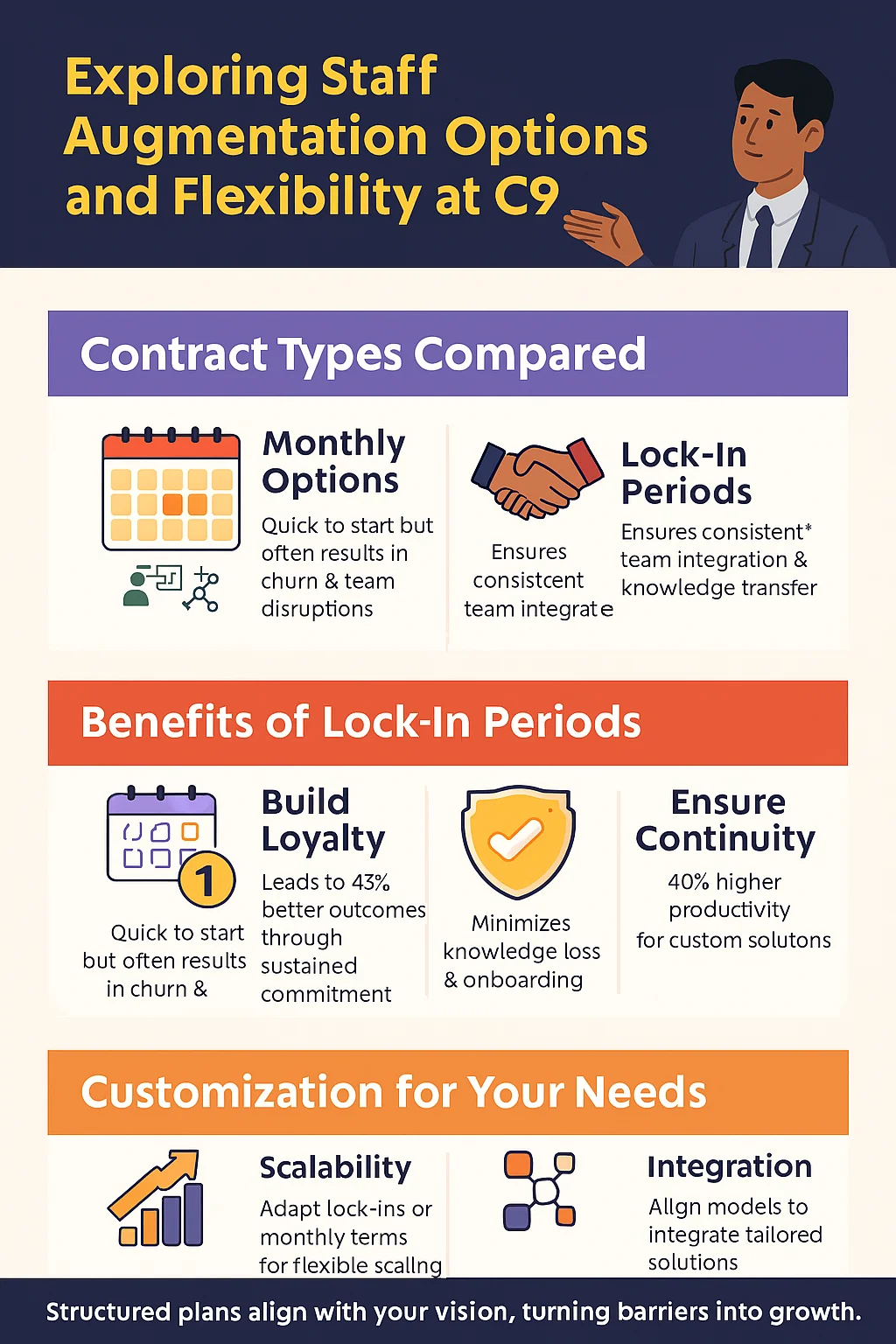
As a detailed-oriented Australian business owner or executive, you're deeply invested in making analytical decisions that drive your organisation's profitability and competitive edge. Yet, the pain of inflexible contracts in staff augmentation often looms large, creating hesitation when scaling your development and integration teams. Monthly options might seem appealing for their low-commitment allure, promising quick trials without long-term ties, but they frequently disrupt project momentum, leaving you grappling with inconsistent delivery amid high operational costs and outdated legacy systems.
Opting for short-term gigs or month-to-month arrangements leads to inconsistent teams that struggle to gel, resulting in knowledge loss as experts cycle in and out without building institutional memory. This fragmentation stalls projects, amplifies turnover risks, and escalates inefficiencies—industry data reveals that short-term engagements contribute to scope creep in 63% of IT projects, with overruns averaging 27% and failure rates climbing to 70% when teams lack continuity. For Australian executives facing triggers like missing growth targets or competitors' tech launches, this means wasted resources, poor customer experiences from delayed integrations, and a eroded competitive advantage—barriers compounded by previous vendor disappointments and internal resistance to unstable setups.
The solution is rooted in flexible yet structured options that prioritise stability and value: At C9, we offer innovative staff augmentation models, including minimum 3-6 month lock-in contracts versus more fluid monthly ones, tailored to your collaborative needs. Why is a 3-6 month commitment better? It fosters deeper team integration, ensures consistent productivity, and facilitates effective knowledge transfer, minimising turnover and maximising ROI—studies show that longer-term augmentations (beyond monthly cycles) yield 62% higher long-term ROI through structured knowledge sharing and boost project success rates by 44% in integration-heavy initiatives. For example, a 3-month lock-in enables augmented developers to fully align with your processes, culture, and goals, delivering 25-40% faster value and 30% quicker project completion compared to fragmented monthly setups, while addressing your goals of cost reduction and efficiency gains. Our trustworthy approach at C9 ensures these options scale seamlessly with your custom software, apps, integration, and database needs, turning potential barriers into opportunities for sustained growth.
Contract Types Compared
When evaluating staff augmentation contracts, it's essential to weigh lock-in periods against monthly arrangements through an analytical lens. Lock-in contracts, such as our 3-6 month minimums, provide stability by committing resources for a defined timeframe, allowing for deeper immersion and reduced administrative churn—ideal for projects requiring ongoing collaboration. In contrast, monthly contracts offer trials for low-risk testing or short spikes, but they often yield suboptimal outcomes due to frequent renegotiations and team instability, with data indicating 78% of businesses report better agility from structured, longer commitments over ad-hoc monthly gigs. At C9, we recommend the former for most Australian executives, as it aligns with your driven pursuit of reliable, high-ROI tech solutions—ensuring projects don't falter from turnover while maintaining flexibility to extend as needed.
Benefits of Lock-In Periods
Lock-in periods in staff augmentation aren't rigid constraints; they're strategic enablers that foster loyalty, reduce risks, and ensure project continuity. A 3-6 month commitment builds team loyalty by incentivising augmented experts to invest in your success, leading to 43% improved project outcomes through consistent, skilled contributions. Risk reduction is profound: longer terms minimise knowledge loss and onboarding redundancies, with organisations reporting 40% higher productivity and 30% faster completions when teams have time to integrate deeply. Continuity shines in complex integrations, where sustained presence prevents stalls—crucial for overcoming outdated systems and delivering seamless custom software. At C9, these benefits translate to trustworthy partnerships that empower your team, driving revenues while addressing barriers like internal expertise gaps.
Customisation for Your Needs
True flexibility in staff augmentation lies in customisation tailored to your specific goals, from scalability to seamless integration. At C9, we adapt our models—whether 3-6 month lock-ins for stability or monthly for pilots—to your analytical requirements, ensuring augmented resources align with your scalability needs during growth phases or integration challenges. For instance, if high costs trigger concerns, our lock-in options optimise budgets with predictable pricing, while knowledge transfer builds long-term value—yielding 62% higher ROI for capability-focused engagements. This collaborative customisation overcomes uncertainties, turning your vision into efficient, innovative outcomes that give a competitive edge in Australia's dynamic market.
The Critical Role of Discovery Calls – Don't Skip This Step
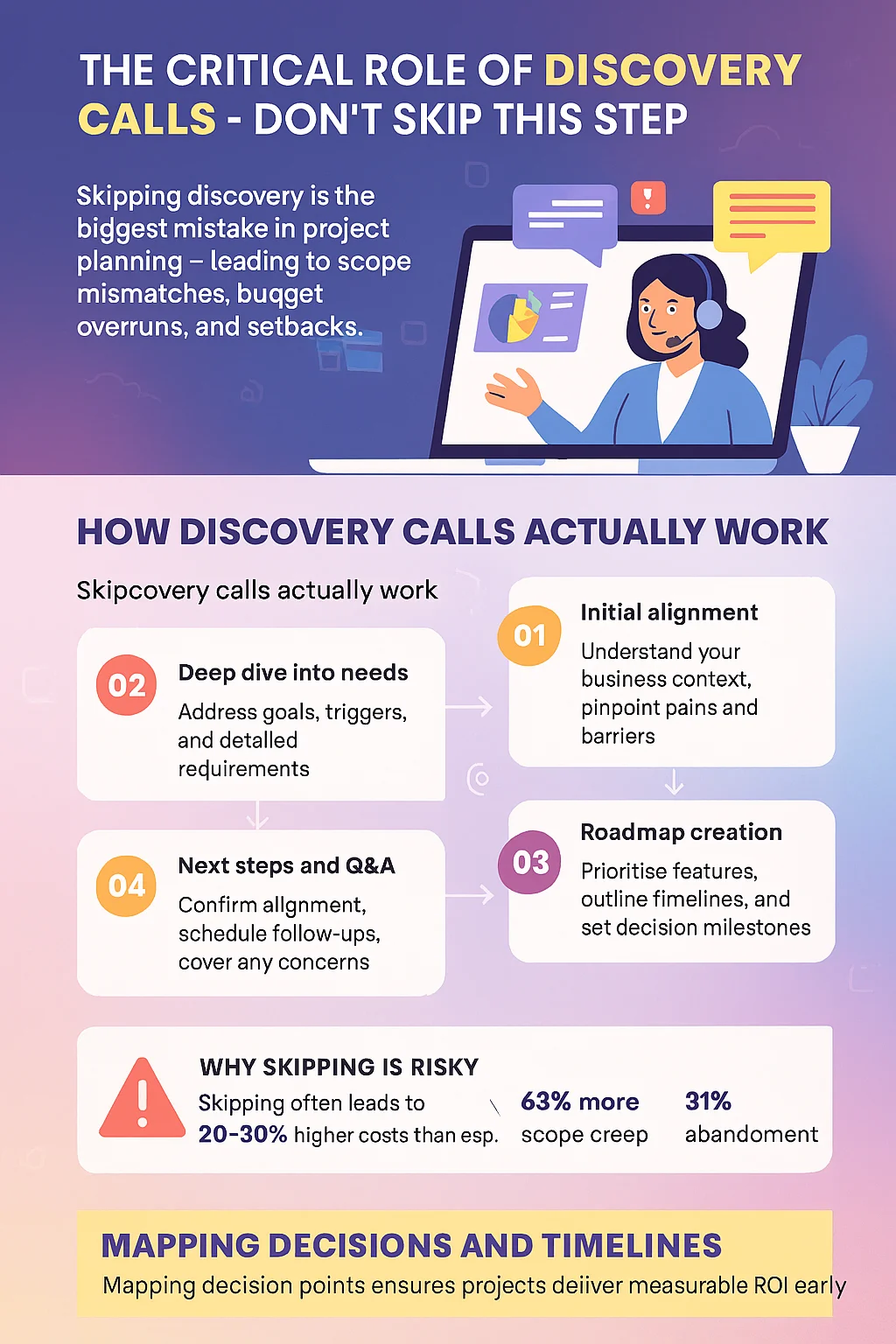
As a driven Australian business owner or executive, you're no stranger to the analytical rigour required to steer your organisation toward greater efficiency and profitability. Yet, uncertainty about where to begin a software development or staff augmentation project often looms large—a common pain that tempts many to skip foundational steps in pursuit of quick progress. This hesitation stems from concerns over time commitments, previous vendor mishaps, and the pressure to deliver results amid high operational costs and outdated legacy systems.
Bypassing the discovery phase isn't just a minor oversight; it's a worst idea that can lead to catastrophic mismatches in project scope, spiralling budget overruns, and outright failures that waste precious resources. Statistics paint a grim picture: nearly 70% of IT projects experience failure rates, with 31% cancelled before completion and 52.7% exceeding original budgets by a staggering 189% on average. Poor planning or skipped discovery contributes heavily, resulting in 63% of projects suffering from scope creep, where unplanned changes inflate costs by 27% on average—and for troubled initiatives, overruns can balloon to 447%. For Australian executives like you, this means not only financial drain but also delayed growth targets, poor customer experiences from flawed integrations, and a competitive disadvantage as rivals launch superior tech capabilities. Resistance to change from your team intensifies, and without alignment, you're left rectifying errors that could have been avoided, amplifying barriers like lack of internal expertise and eroding trust in the process.
The solution shines through with clarity: Discovery calls are pivotal, serving as a collaborative gateway to map decision points, timelines, and requirements in a focused 30-60 minute session. Far from a time sink, they're an essential investment that prevents costly revisions, aligns expectations, and sets the stage for success—reducing risks by up to 30% through enhanced planning and stakeholder alignment. At C9, we begin by assessing your specific pains (e.g., high costs and outdated systems), goals (e.g., operational efficiency and revenue growth), and triggers (e.g., competitors' advancements), then craft a tailored roadmap with staged projects designed for early ROI. This innovative approach ensures quick wins, such as a prototype delivering immediate value, which feeds savings back into future improvements—empowering your organisation with trustworthy, scalable solutions. By prioritising discovery, we eliminate assumptions, clarify objectives, and foster a partnership that drives your competitive edge without the pitfalls of rushed engagements.
How Discovery Calls Work Step-by-Step
Our discovery calls at C9 unfold in a structured, collaborative manner to maximise insight while respecting your time.
Step 1: Initial Alignment (10-15 minutes)—We start with an open discussion to understand your business context, pinpointing pains like resistance to change and barriers such as vendor uncertainties.
Step 2: Deep Dive into Needs (15-20 minutes)—We explore goals, triggers, and requirements, using targeted questions to uncover non-functional aspects like security and scalability.
Step 3: Roadmap Creation (10-15 minutes)—We synthesise findings into a phased plan, prioritising features for early ROI and outlining timelines with decision milestones.
Step 4: Next Steps and Q&A (5-10 minutes)—We address concerns, confirm alignment, and schedule follow-ups, ensuring you leave with actionable insights. This process isn't rigid; it's insightful and adaptive, turning vague ideas into a precise, trustworthy blueprint for your staff augmentation or custom software needs.
Why Skipping is Risky
Forgoing discovery invites unnecessary peril: without it, projects face 20-30% higher costs from misalignments, as assumptions lead to rework and inefficiencies that average 27% overruns across software initiatives. In Australia, where talent shortages amplify these issues, skipping means heightened scope creep (affecting 63% of unplanned projects), delayed deliveries, and eroded team morale—ultimately jeopardising your goals of cost reduction and competitive advantage. Real-world data shows that 31% of projects are abandoned outright due to such foundational flaws, turning potential innovations into costly regrets.
Mapping Decisions and Timelines
Discovery excels at ensuring precise planning tailored to your driven agenda, by mapping key decision points—like budget approvals and feature prioritisation—against realistic timelines. This creates a staged framework where early phases deliver measurable ROI, such as efficiency gains that fund subsequent work, aligning with your analytical pursuit of profitability. At C9, this collaborative mapping reduces uncertainties, fosters buy-in from stakeholders, and positions your organisation for sustained growth amid evolving tech landscapes.
Top FAQs on Staff Augmentation – Answered for Australian Executives
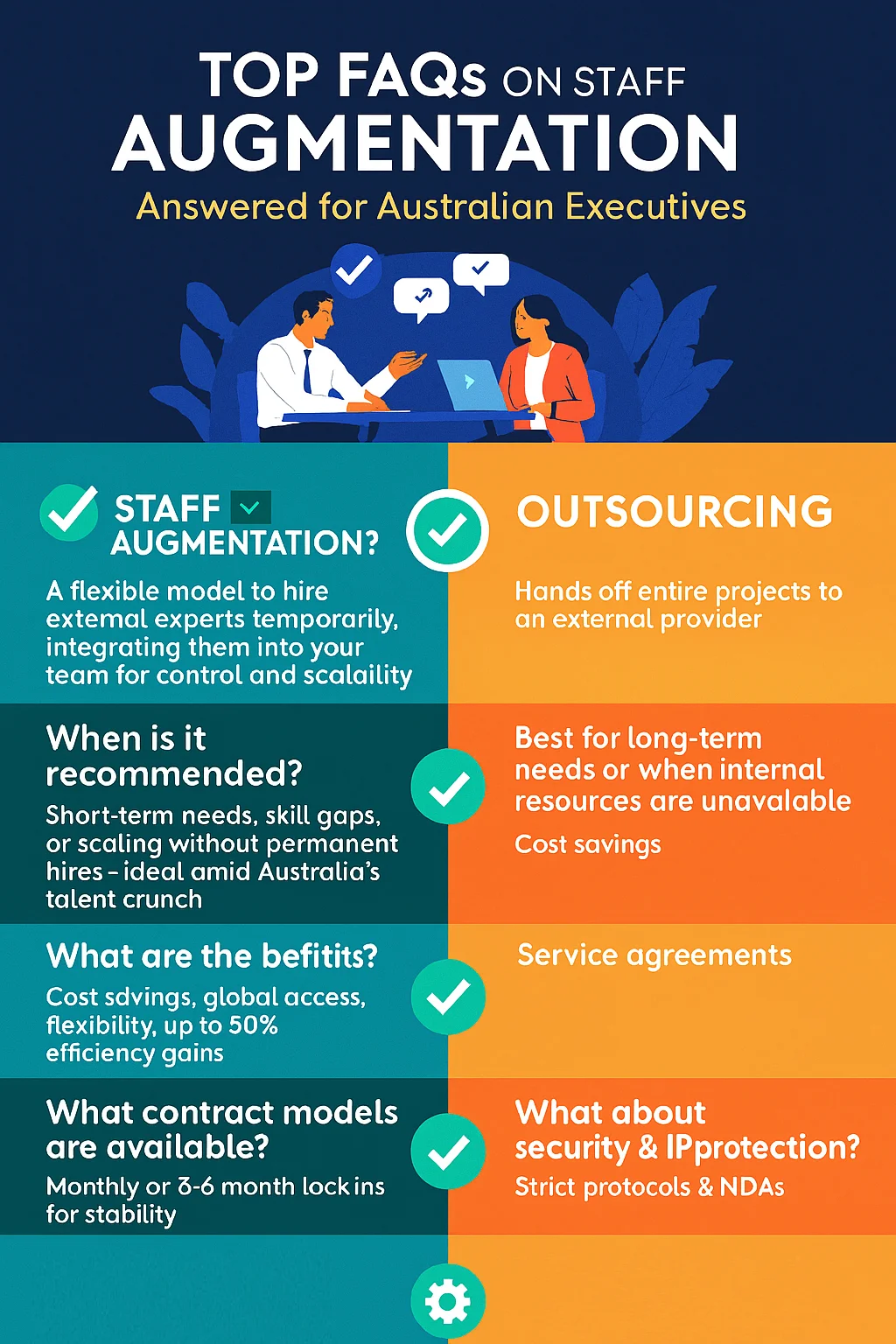
What is staff augmentation?
A flexible model to hire external experts temporarily, integrating them into your team for control and scalability.
When is it recommended?
For short-term needs, skill gaps, or scaling without permanent hires—ideal amid Australia's talent crunch.
What are the benefits?
Cost savings, global access, flexibility, and faster delivery—up to 50% efficiency gains.
How does it differ from outsourcing?
You retain control; outsourcing hands off entire projects.
What contract models are available?
Monthly or 3-6 month lock-ins; the latter for stability.
How do you ensure team integration?
Through collaborative tools and knowledge transfer at C9.
What about security and IP protection?
Strict protocols and NDAs safeguard your assets.
Can we scale up or down?
Yes, flexibly—our model supports it seamlessly.
How long does onboarding take?
Typically 1-2 weeks, faster than traditional hiring.
What industries do you specialise in?
Custom software for various sectors, tailored to Australian needs.
The Pitfalls of Indicative Pricing – Why Discovery-Based Pricing Wins
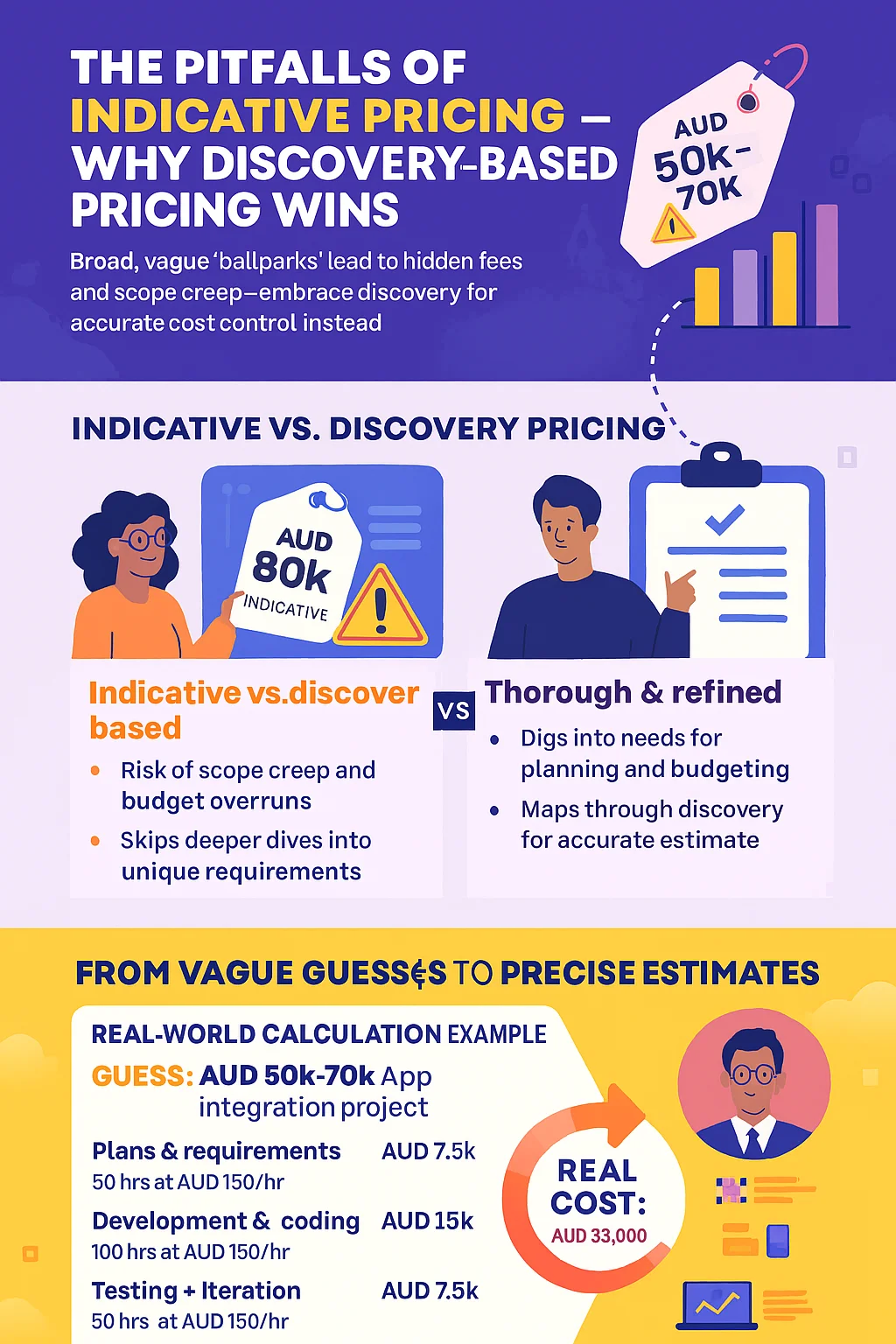
As a detailed-oriented Australian business owner or executive, you're accustomed to scrutinising every aspect of your operations to drive efficiency and profitability. Yet, when it comes to software development projects, relying on indicative pricing proposals can feel like a convenient shortcut—those broad, ballpark estimates that promise quick answers without the upfront effort. But this approach is a painful trap: vague quotes based on assumptions often mask the true scope, leading to hidden fees, unexpected add-ons, and a cascade of financial surprises that erode your hard-earned margins.
These indicative proposals aren't worth the paper they're written on. They stem from incomplete information, fostering unrealistic assumptions about project complexity, timelines, and requirements. The result? Rampant scope creep, where initial features balloon into unplanned extras, causing budget overruns that average 27% across industries, with some complex software projects spiralling to 50-200% beyond estimates. Alarmingly, nearly 70% of software projects experience these overruns, often due to inadequate requirement analysis, unrealistic timelines, and insufficient testing—pitfalls that indicative pricing fails to address. For Australian executives like you, this means not just financial strain but also delayed launches, frustrated teams, and missed opportunities to outpace competitors with new tech capabilities. Hidden costs, such as vendor lock-in or low-initial-price traps, compound the frustration, turning what seemed like a savvy decision into a costly nightmare that hinders your goals of reducing operational expenses and gaining a competitive edge.
The solution is clear: embrace discovery-based pricing, a refined approach that uncovers the true scope through thorough analysis, delivering estimates precise to the nearest hour rather than indicative's rough approximations to the nearest day or week. This method mitigates risks by identifying requirements early, controlling budgets, and ensuring accurate resource allocation—ultimately reducing long-term expenses by preventing costly revisions and improving efficiency. At C9, we prioritise discovery as the foundation of our staff augmentation services, allowing us to break projects into manageable stages for early ROI. This not only aligns with your analytical mindset but also feeds savings from initial phases into future improvements, fostering sustainable growth. For instance, in a typical app integration project, an indicative quote might loosely estimate AUD 50,000-70,000 based on high-level guesses, ignoring nuances like custom integrations or compliance needs. In contrast, post-discovery, we calculate with precision: planning and requirements gathering (50 hours at AUD 150/hour = AUD 7,500), core development and coding (100 hours = AUD 15,000), rigorous testing and iterations (50 hours = AUD 7,500), and deployment with knowledge transfer (20 hours = AUD 3,000), totalling a refined AUD 33,000. This staged breakdown delivers quick wins—like a functional prototype in the first phase—generating immediate value that offsets costs and builds momentum. Always prioritise discovery—it's the key to accuracy, value, and avoiding the 57% of organisations that report frequent budget issues in software projects.
Indicative vs. Discovery Pricing Explained
Indicative pricing is rough and assumption-driven, often leading to scope creep and overruns because it skips deep dives into your unique needs, such as outdated legacy systems or integration challenges. Discovery pricing, however, refines everything—uncovering the true scope through stakeholder interviews, requirement mapping, and feasibility assessments. This results in a detailed cost breakdown that aligns with strict financial constraints, prioritising key functions and reducing risks by up to 30% through better planning. At C9, our discovery process ensures transparency, turning vague estimates into trustworthy roadmaps that support your driven pursuit of efficiency and profits.
Real-World Calculation Example
To illustrate the precision, consider a mid-sized Australian retailer seeking custom software for inventory integration amid high operational costs. An indicative proposal might ballpark AUD 80,000-120,000, based on generic assumptions about data volumes and user interfaces. But after a C9 discovery call—where we map pain points like poor customer experiences and resistance to change—we deliver a granular breakdown: initial scoping and wireframing (60 hours at AUD 150/hour = AUD 9,000), backend development with API integrations (120 hours = AUD 18,000), frontend UI/UX enhancements (80 hours = AUD 12,000), quality assurance and security testing (40 hours = AUD 6,000), and final deployment with training (20 hours = AUD 3,000), for a total of AUD 48,000. This not only undercuts the indicative range but stages the project: Phase 1 (scoping and basic integration) delivers early ROI through immediate efficiency gains, such as 20% faster inventory tracking, freeing up budget for advanced features in later phases. Such accuracy prevents the 47% of Agile projects that face overruns due to poor initial estimates, showcasing how discovery transforms potential pitfalls into predictable success.
Breaking Projects into Stages for ROI
In an Agile framework, breaking projects into stages—such as initiation, planning, development, production, and retirement—maximises efficiency by delivering quick wins that accelerate ROI. This approach aligns teams with business strategy, allowing for iterative releases where early phases generate value—like a minimum viable product (MVP) that boosts revenues sooner—while feeding savings into subsequent improvements. At C9, we use this to address your triggers, such as missing growth targets, by ensuring each stage measures success through metrics like defect rates and user satisfaction, ultimately driving higher profits and a competitive advantage.
Embrace the Future with C9's Staff Augmentation
You've felt the pains of shortages and costs, the agitation of falling behind, and now the solutions through C9's innovative, trustworthy staff augmentation. Revolutionise your business today.
Schedule Your Free Discovery Call Today
Don't let barriers hold you back—visit https://www.c9.com.au/ to book a no-obligation discovery call. Let's collaborate on your path to efficiency, savings, and growth. Contact us now!